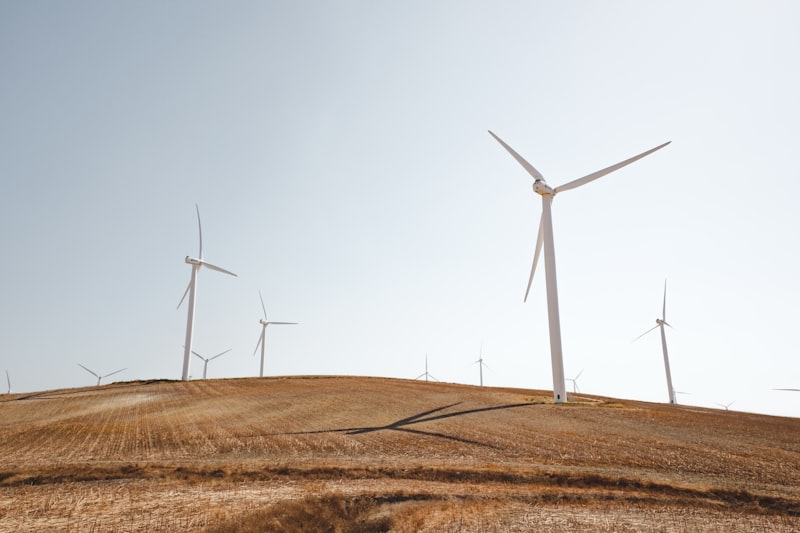One of the most significant impacts of technology on environmental protection is its role in monitoring and reducing pollution. Advanced sensors and monitoring devices now allow us to track pollutants in real-time, pinpointing sources of contamination swiftly and accurately. This capability enables faster response times and more effective mitigation strategies, ensuring cleaner air and water for communities worldwide.
Moreover, technology has revolutionized waste management. Automated sorting systems powered by AI and robotics can now segregate recyclable materials with incredible precision and efficiency. This not only increases recycling rates but also reduces the amount of waste ending up in landfills or oceans. Imagine a world where every piece of plastic, glass, or metal is sorted and reused, minimizing our impact on the environment.
Renewable energy has also benefited immensely from technological advancements. Solar panels and wind turbines, once considered niche technologies, are now mainstream energy sources thanks to innovations in materials and manufacturing processes. These clean energy solutions not only reduce our dependence on fossil fuels but also help combat climate change by lowering greenhouse gas emissions.
Furthermore, the advent of digital communication and collaboration tools has transformed how environmental organizations operate. They can now coordinate conservation efforts on a global scale, share data instantaneously, and mobilize support like never before. Technology has broken down barriers and united environmentalists worldwide in their quest to protect endangered species and ecosystems.
From Drones to Data: Technology’s Role in Monitoring Endangered Species
Drones, once confined to military applications and aerial photography, have now become invaluable tools in conservation biology. These unmanned aerial vehicles can access remote and rugged terrains that are difficult or impossible for humans to reach. Equipped with high-resolution cameras and thermal imaging capabilities, drones can survey vast areas quickly and efficiently. They provide biologists with detailed information about animal populations, nesting sites, and even illegal activities like poaching.
But drones are just one piece of the puzzle. The data they collect is equally critical. Advanced analytics and machine learning algorithms process this data, transforming raw aerial footage into actionable insights. Researchers can analyze animal behavior patterns, detect changes in population dynamics, and predict environmental changes that may impact species survival. This wealth of information empowers conservationists to make informed decisions and allocate resources where they are most needed.
Take, for example, the monitoring of sea turtle nesting sites. Traditionally, researchers would conduct manual surveys, which were time-consuming and often invasive to the animals. Now, drones can fly over beaches, photograph nests, and count turtles—all without disturbing them. This non-invasive approach not only reduces stress on the turtles but also provides accurate data that can guide conservation strategies.
In addition to drones, technologies like satellite tracking and acoustic monitoring play crucial roles in safeguarding endangered species. Satellite tags attached to animals transmit their location data, allowing scientists to monitor migrations and identify critical habitats. Acoustic sensors capture sounds in the wild, helping researchers study animal vocalizations and detect illegal activities such as logging or poaching.
As technology continues to advance, so too does our ability to protect Earth’s most vulnerable inhabitants. By harnessing the power of drones, data analytics, and other cutting-edge tools, we can monitor endangered species more effectively than ever before. This intersection of innovation and conservation holds tremendous promise for the future of biodiversity on our planet.
Smart Sensors and AI: Revolutionizing Waste Management Practices
Imagine a world where garbage cans are no longer just receptacles but smart devices that can think and act. Thanks to advancements in technology, this vision is becoming a reality through the integration of smart sensors and artificial intelligence (AI) in waste management practices.
Smart sensors, small yet powerful devices embedded in trash bins, collect real-time data on fill-levels and conditions. They monitor how full a bin is, detect any unusual odors, or even track the temperature inside. This information is transmitted wirelessly to a central management system, where AI algorithms analyze and process the data.
One of the key benefits of this technology is optimization. By knowing exactly when bins are full, waste management companies can schedule collections more efficiently. No more overflowing bins or unnecessary trips for collection trucks, which reduces fuel consumption and emissions, making our cities cleaner and greener.
Moreover, AI plays a crucial role in predicting waste generation patterns. By analyzing historical data and current trends, AI can forecast when and where more waste will be generated. This foresight allows municipalities to allocate resources better and plan for peak disposal times, ensuring that services are always responsive to community needs.
But it’s not just about efficiency; smart sensors and AI also enhance public health. By promptly identifying bins that are nearing capacity, these technologies help prevent littering and the spread of pests and diseases associated with waste accumulation.
In essence, smart sensors and AI are transforming waste management into a proactive, data-driven process. They enable cities to save costs, reduce environmental impact, and improve overall quality of life for residents. As technology continues to evolve, we can expect even more innovations in how we handle waste, moving us towards a cleaner and more sustainable future.
Satellite Imaging: Unveiling the Hidden Impact of Deforestation
Satellite imaging technology utilizes powerful cameras and sensors mounted on satellites orbiting high above the Earth. These satellites capture images with remarkable clarity and precision, enabling scientists and researchers to monitor changes in forest cover over time. From the lush green canopies of tropical rainforests to the barren landscapes left behind by deforestation, these images provide a visual narrative of environmental degradation.

The impact of deforestation, as revealed by satellite imaging, is staggering. It shows us the vast swaths of land that have been cleared for agriculture, logging, and urban development, leading to habitat loss for countless species and disrupting delicate ecosystems. These images serve as a stark reminder of the consequences of unchecked human activity on our planet’s biodiversity and climate.
Moreover, satellite imaging allows us to track deforestation trends globally, highlighting hotspots where the rate of forest loss is particularly acute. This information is crucial for policymakers and conservationists seeking to implement strategies for forest protection and restoration. By analyzing these images, scientists can also estimate carbon emissions released into the atmosphere due to deforestation, further emphasizing its impact on climate change.
Satellite imaging offers a powerful tool for unveiling the hidden impact of deforestation. It transcends borders and provides a comprehensive view of environmental change on a global scale. Through these images, we gain insight into the urgency of protecting our forests and preserving the natural heritage that sustains life on Earth.
Blockchain and Sustainability: Transparent Supply Chains for a Greener Future
Have you ever wondered how blockchain technology could revolutionize sustainability efforts across industries? Imagine a world where every step of a product’s journey, from raw material sourcing to delivery, is transparent and traceable. This vision is becoming a reality with blockchain, offering unprecedented opportunities to build greener, more ethical supply chains.

Blockchain, originally developed for cryptocurrencies like Bitcoin, is a decentralized ledger technology. It allows information to be recorded in a secure, transparent, and immutable manner across a network of computers. In the context of sustainability, blockchain’s ability to create a verifiable record of every transaction and interaction within a supply chain is game-changing. It ensures that claims about environmental impact and ethical practices can be backed by undeniable proof.
One of the key challenges in achieving sustainability goals is the lack of transparency in supply chains. Often, consumers and businesses alike are left in the dark about where products come from and under what conditions they were produced. Blockchain addresses this by providing a digital trail that documents every touchpoint, ensuring accountability at every stage.
For example, imagine buying a piece of clothing and being able to scan a QR code to see every supplier involved, where the materials were sourced, and whether fair labor practices were upheld. This level of transparency empowers consumers to make informed choices that align with their values, nudging companies towards more sustainable practices to meet consumer demand.
Moreover, blockchain enhances efficiency in supply chains by reducing paperwork, streamlining logistics, and minimizing errors. This not only cuts down on administrative costs but also reduces the carbon footprint associated with traditional paper-based processes.
In essence, blockchain technology isn’t just about financial transactions; it’s about transforming industries towards a more sustainable future. By fostering transparency and accountability, blockchain enables businesses to build trust with consumers and stakeholders while driving innovation towards greener practices.
Robotics in Marine Conservation: Cleaning Oceans One Reef at a Time
Robots designed for marine conservation come in various forms, each with its unique set of capabilities. Some resemble sleek submarines, equipped with sensors and cameras that allow them to navigate through intricate coral formations with precision. Others are more agile, resembling robotic fish that can swim effortlessly among sea creatures without causing disturbance. These robots aren’t just tools; they’re guardians of the ocean, monitoring environmental conditions and collecting vital data to aid scientists in their conservation efforts.
One of the most impressive feats of these marine robots is their ability to clean up coral reefs. Coral reefs are crucial ecosystems that support a staggering amount of marine life, yet they are under constant threat from pollution and climate change. Robots equipped with specialized arms can remove invasive species, debris, and even pollutants from delicate coral structures without causing harm. This targeted approach not only helps in preserving existing coral but also encourages new growth, allowing these vibrant underwater gardens to thrive once more.
Moreover, these robots play a crucial role in monitoring and protecting marine biodiversity. They can survey vast areas of the ocean floor much faster and more efficiently than human divers, capturing detailed images and data that provide invaluable insights into the health of underwater ecosystems. By detecting early signs of damage or stress, these robots enable conservationists to take timely action to mitigate threats and preserve biodiversity.
In essence, robotics in marine conservation is more than just a technological advancement—it’s a lifeline for our oceans. By combining innovation with environmental stewardship, these robots are cleaning oceans one reef at a time, ensuring that future generations can continue to marvel at the beauty and diversity of our underwater world.
Virtual Reality: Educating the Masses on Environmental Conservation
One of the key challenges in environmental conservation is bridging the gap between scientific knowledge and public awareness. Many people understand the importance of preserving nature theoretically, but few have experienced the raw beauty and intricate ecosystems firsthand. Here’s where VR steps in as a game-changer. By simulating realistic environments and scenarios, VR experiences can evoke emotional connections and a sense of urgency like never before.
Picture this: you put on a VR headset and find yourself standing amidst towering trees in the Amazon rainforest. You hear the vibrant calls of exotic birds, feel the humidity on your skin, and see the rich biodiversity around you. Suddenly, a virtual guide appears to explain the delicate balance of this ecosystem and the threats it faces. This interactive and sensory experience leaves a lasting impression, far more impactful than reading about deforestation in a textbook.
Moreover, VR allows educators to tailor experiences to different learning styles and age groups. Whether you’re a child learning about ecosystems for the first time or an adult looking to deepen your understanding of climate change, VR can adapt to suit your educational needs. It’s like having a personal tour guide through the world’s most endangered habitats, sparking curiosity and fostering a deeper appreciation for our planet’s natural wonders.
Beyond education, VR can also empower individuals to take action. By immersing users in virtual environments affected by human activity, such as polluted oceans or melting glaciers, VR prompts reflection and encourages behavioral changes that support conservation efforts. This technology has the potential to transform passive observers into proactive advocates for environmental stewardship.
VR is revolutionizing how we educate the masses about environmental conservation by providing immersive, engaging, and impactful experiences. It transcends geographical boundaries and empowers individuals to connect with nature in profound ways. As VR technology continues to advance, so too will its role in shaping a more informed and environmentally conscious global community.
Frequently Asked Questions
Can technology help in reducing carbon emissions
Learn how technology can effectively reduce carbon emissions through innovative solutions and sustainable practices.
What role do smart sensors play in environmental monitoring
Learn how smart sensors contribute to environmental monitoring by collecting real-time data on air quality, water levels, and more. Explore their role in enhancing precision, efficiency, and sustainability in monitoring ecosystems and urban environments.
How does technology contribute to wildlife conservation efforts
Discover how technology aids wildlife conservation efforts through tools like GPS tracking, drones for monitoring, and data analytics. These innovations help researchers and conservationists better understand animal behavior, track endangered species, and protect habitats more effectively.
What are examples of technology aiding air and water quality improvement
Explore various technologies like air purifiers, catalytic converters, and wastewater treatment plants that contribute to enhancing air and water quality. Learn how these innovations help mitigate pollutants and promote healthier environments.
How is renewable energy technology impacting sustainability
Learn how renewable energy technology contributes to sustainability by reducing reliance on fossil fuels, minimizing environmental impact, and promoting long-term energy security.


